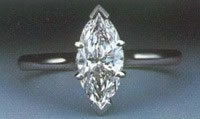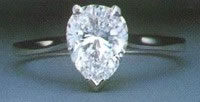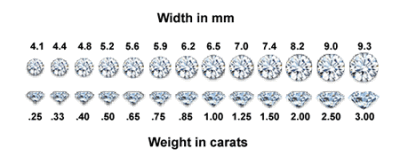The weight of a diamonds is generally given in carats. The term carat originated in ancient times when gemstones were weighted against the carob bean. Each bean weighed about one carat. In 1913, carat weight was standardized internationally and adapted to the metric system. One carat equals 0.2 grams – a little more than 0.007 ounce. In other words, it takes 142 carats to equal 1 ounce.
Two terms, carat and karat are often confused. In the US, karat refers to the fineness of gold alloys (pure gold is 24 karat; 14 karat is 14 parts gold and 10 parts other metals) and carat refers to gem weights.
 The weight of small diamonds is frequently expressed in points, with one point equaling 0.01 carats. For example, five points is a short way of saying 5/100 of a carat and fifty points equates to a half carat.
The weight of small diamonds is frequently expressed in points, with one point equaling 0.01 carats. For example, five points is a short way of saying 5/100 of a carat and fifty points equates to a half carat.
Sometimes in the jewelry trade, the term size is used as a synonym for carat weight. This is because small round diamonds having the same weight also look the same size and similar diameters. As diamonds increase in weight, their size becomes less predictable. Diamonds with a shallow cut can have a greater diameter than a deeper cut diamond with the same weight. However, you don’t want the diamond to be too shallow or it will not reflect the light properly and will have less brilliance.
 It is similar to asking how tall a 200 pound man is. You have no way of knowing because you don’t know how the man is proportioned. The same holds true for diamonds. So if size is important to you, focus on diamond measurements as opposed to carat weight. You don’t need to carry a millimeter gauge when you go shopping. Just start asking what the different millimeter measurements are and note how they look. Diamonds that look big for their weight may have reduced brilliance and fire so always insist on great cut.
It is similar to asking how tall a 200 pound man is. You have no way of knowing because you don’t know how the man is proportioned. The same holds true for diamonds. So if size is important to you, focus on diamond measurements as opposed to carat weight. You don’t need to carry a millimeter gauge when you go shopping. Just start asking what the different millimeter measurements are and note how they look. Diamonds that look big for their weight may have reduced brilliance and fire so always insist on great cut.
Note that an increase in carat weight does not produce the same increase in millimeter diameter. For example, there is a 25% increase in carat weight from 1.00 carats to 1.25 carats but less than 8% increase in diameter (6.5 to 7.0 mm). This concept, along with the increased price per carat, explains why prices increase dramatically in order to get noticeably bigger millimeter size.
 The weight of a diamond has a large impact on price. All other factors being equal, the heavier the diamond, the greater its cost will be. Diamonds lose approximately 40-60% of their rough weight when they are cut. Over 1 million rough diamonds must be mined before one is found that can be cut into a 1.00 carat finished diamond!
The weight of a diamond has a large impact on price. All other factors being equal, the heavier the diamond, the greater its cost will be. Diamonds lose approximately 40-60% of their rough weight when they are cut. Over 1 million rough diamonds must be mined before one is found that can be cut into a 1.00 carat finished diamond!
With each weight category increase (quarter, third, half), the value per carat of a diamond will increase significantly and almost geometrically (given all have the same other factors). A stone which is twice as large as an otherwise identical smaller stone might be three or more times more expensive. So while you might see a price for a smaller stone at $2,000 per carat, as you price the same cut, color and clarity in a larger stone you’ll see dramatic increases.
There are standards for reporting a diamond’s weight. FTC guidelines allow a one-half point (1/2) tolerance in the stated weight of a diamond. For example, a diamond weighing .495 carat can be legally sold as a 50 point diamond, while a .494 carat diamond must be sold as a 49 point stone. Some stores sell diamonds according to size ranges so you need to insist on knowing the exact weight of your loose diamond.
Advice: Look for diamonds that have a diameter measurement that is at least as large as the average for that weight. In other words, don’t pay for weight you can’t see.
What size diamond should you buy? The answer should be based on two criteria. The first is budget and the second is her expectations. Let’s talk about expectations first.
 Perhaps the most significant factor in determining how big a diamond she is expecting is what size diamond her “comparison” group has. The comparison group consists of her friends, neighbors, relatives and perhaps that troublesome coworker. She might not tell you that she wants something bigger than a carat, but if all her friends have diamonds larger than a carat that is what we will be hoping for. Pay attention to what size diamond her friends and family have and you will have a much better understanding of her true expectations.
Perhaps the most significant factor in determining how big a diamond she is expecting is what size diamond her “comparison” group has. The comparison group consists of her friends, neighbors, relatives and perhaps that troublesome coworker. She might not tell you that she wants something bigger than a carat, but if all her friends have diamonds larger than a carat that is what we will be hoping for. Pay attention to what size diamond her friends and family have and you will have a much better understanding of her true expectations.
The rule of thumb from a budget standpoint is that an engagement diamond purchase should be equal to about two months salary. Obviously this is only a benchmark and your situation is different than any one else’s. Since this is a purchase that you both will be enjoying for years to come, it is usually better to buy as large a diamond as possible. This will avoid her wanting an upgrade in a short amount of time.
Advice: Before you start shopping, pay close attention to what size diamond her friends have and what your budget can afford. We don’t know many people who wish they had bought a “smaller” engagement diamond.
Estimating Carat Weight
If a diamond is not loose, there are formulas that can be used to find the approximate weight of a diamond. All measurements are to be made in millimeters (mm).
ROUND: largest diameter x smallest diameter x depth x .0061= carat weight
OVAL: largest diameter x smallest diameter x depth x .0062= carat weight

EMERALD: length x width x depth x 2. 417 x .0025= carat weight
RECTANGLE: length x width x depth x 2.417 x .0026= carat weight

SQUARE: length x width x depth x 2.417 x .0023= carat weight

MARQUISE: length x width x depth x 2.417 x .0016= carat weight

PEAR: length x width x depth x 2.417 x .0018= carat weight
TRIANGLE: length x width x depth x .0057= carat weight

HEART SHAPE: length x width x depth x .0059= carat weight
Please note that although these formulas are normally fairly accurate, the results will only be as accurate as your measurements and will still only be an estimate. The only sure method for determining the true weight of a diamonds is to weigh it loose on a balance or scale designed specifically for that purpose.


